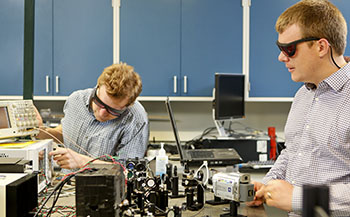
ORNL researchers Raphael Pooser (left) and Benjamin Lawrie used quantum correlated beams of light to boost detection levels from microcantilever-based sensors. [Image: Oak Ridge National Laboratory, USA]
By cleverly deploying quantum correlated beams of light, researchers from the Oak Ridge National Laboratory (ORNL), USA, have made the first direct measurement of microcantilever beam deflection with a noise floor below the shot-noise limit (SNL), blowing past a fundamental limitation of systems based on classical light (Optica, doi: 10.1364/OPTICA.2.000393). The researchers believe that the results could lead to “a new class of quantum MEMS sensors” that could boost the sensitivity of a variety of microcantilever-based sensor systems, such as atomic force microscopes (AFMs), previously limited by shot noise.
Microcantilevers—diving-board-like structures several microns in size—have found use in a variety of micro-electro-mechanical-system (MEMS) sensor systems. The structures are designed to deflect as molecules are adsorbed onto the cantilever surface, with the effect, on the scale of nanometers, measured by deflection of a low-power laser beam reflected off the cantilever. Two quantum noise sources limit the potential sensitivity of such a system, however: the back-action noise, due to momentum transfer from individual photons, and the SNL, the noise level of the coherent light field itself.
Both noise sources arise from the Heisenberg uncertainty principle. But while techniques exist to reduce the back-action noise, the SNL has heretofore constituted a fundamental barrier for systems based on classical optics.
ORNL researchers Raphael Pooser and Benjamin Lawrie sought a way around that barrier using so-called squeezed light states. These are nonclassical states tuned to “squeeze” the inherent Heisenberg phase–amplitude uncertainty ellipse preferentially in one direction—for example, reducing the uncertainty in the amplitude direction while increasing it in the phase direction, or vice versa. Using such states, says Pooser, “we can surpass the quantum limit without violating the uncertainty principle by moving the noise out of the variable of interest and into an area that we don't care about and don't detect.”
To put the idea into practice, the scientists used four-wave mixing (4WM) to create twin beams with entangled spatial modes, each squeezed to reduce intensity quantum noise. Half of the split beam is reflected off of the deflected cantilever; the other half travels a different path. When the two beams re-combine on the detector, the quantum-correlated noise subtracts to yield a noise floor below the SNL.
Pooser and Lawrie report that they could achieve a noise reduction to 60 percent below the SNL using the technique. “By pushing the noise limit lower than ever before,” says Pooser, “we enable these sensors to see things they couldn't see.” And the scientists note that their system used off-the-shelf components and a simple experimental setup that could prove readily adaptable to MEMS devices, which are already ubiquitous in sensing applications, and to emerging nano-electro-mechanical systems (NEMS).
“This marks the first time quantum states have been applied to practical micro-electro-mechanical systems,” says Lawrie. “The method we used to improve sensitivity is highly compatible with existing sensing and imaging platforms.”
